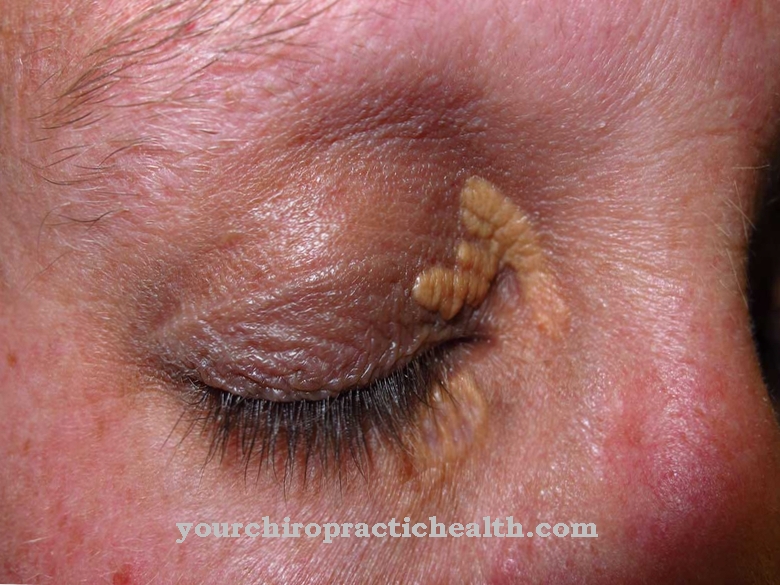In the Amyloid angiopathy it is a disease that affects the blood vessels in the brain. Beta-amyloids are deposited inside the blood vessels, causing the lumen to narrow. In addition, microaneurysms sometimes develop. This creates a risk that the aneurysms will burst and cause bleeding in the brain.
What is amyloid angiopathy?

The amyloid angiopathy is synonymous with cerebral amyloid angiopathy or the abbreviation CAA designated. In 1938, the researcher Scholz first described amyloid angiopathy in elderly patients. In doing so, he discovered the typical deposits of beta amyloids in people's brains.
As there are certain parallels in the signs of the disease, amyloid angiopathy was initially counted as Alzheimer's disease. However, researchers later found that amyloid angiopathy was a disease in its own right. Amyloid angiopathy does not arise as a result of hypertension, which is the cause of numerous other cerebral hemorrhages.
Beta-amyloid deposits are most common in amyloid angiopathy. The majority of patients with Alzheimer's disease suffer from such symptoms. There are also several genetically caused types of amyloid angiopathy. There are genetic mutations that affect presenilin and the amyloid precursor protein, for example. A gene mutation of cystatin C also occurs in some cases.
Amyloid angiopathy and the associated complaints arise from the storage of certain peptides in the blood vessels of the brain. In most cases, the beta-amyloid peptide is deposited. The debris accumulates in different areas inside the blood system in the brain. As a result, various stenoses and often microaneurysms develop.
causes
Amyloid angiopathy results from the deposition of the peptide beta-amyloid. This substance is formed when the amyloid precursor protein breaks down. The enzymes gamma and beta secretase are necessary for this. In healthy people, the metabolism does not make these peptides.
It is assumed that primarily nerve cells produce the substance amyloid. The substance accumulates in the patient's nerve water, so that it gradually builds up in the walls of the cerebral blood vessels or the tissue of the brain. These deposits are known as so-called senile plaques and occur mainly in advanced age.
They also occur more frequently in connection with Alzheimer's dementia. Certain genetic factors increase the risk of developing amyloid angiopathy. In particular, the allele called ApoE4 predestines those affected to accumulate appropriate deposits of amyloid in the blood vessels.
You can find your medication here
➔ Medicines against memory disorders and forgetfulnessSymptoms, ailments & signs
Amyloid angiopathy manifests itself primarily in the typical deposits of the peptide beta-amyloid in the blood vessels in the brain. The substance accumulates in particular in the walls of the vessels. A special amyloid precursor protein is necessary for the formation of beta amyloid.
This is created by dividing the precursor substance through enzymatic processes. This is how the pathogenic beta-amyloid is created. Such processes take place exclusively in the neuronal tissue of the patient. In healthy people, on the other hand, the organism does not produce any amounts of beta-amyloid.
The peptide accumulates in the nerve water, the so-called cerebrospinal fluid. Characteristic plaque then forms. These deposits in the tissue of the nerves are largely responsible for the development of Alzheimer's disease.
Diagnosis & course
The diagnosis of amyloid angiopathy is extremely difficult to make in living patients. That is why a reliable diagnosis is often only successful when the deceased is autopsied. This shows minimal bleeding into the tissue of the brain, which has no obvious cause.
This suggests amyloid angiopathy. The diagnosis is based on performing an MRI scan. Here, hyalinized blood vessels are visible, whereby the smooth structures of the muscle cells are lost. The clinical diagnosis is made using imaging tests that reveal isolated or multiple lobar bleeding into the brain.
This bleeding occurs mainly at the border between the cortex and marrow. In addition, microbleeding into the brain is possible that does not reveal any other cause. Statistical evaluations show that around five to twelve percent of intracranial bleeding is caused by amyloid angiopathy.
The information only applies to people older than 55 years. People who have amyloid angiopathy and are taking certain anticoagulants are particularly likely to experience bleeding in the brain.
Complications
Amyloid angiopathy is a relatively serious disease. In the worst case scenario, it can lead to profuse bleeding in the brain, creating a life-threatening situation for the patient. Most people affected develop Alzheimer's disease due to amyloid angiopathy.
This can develop over time and does not have to occur suddenly. It is difficult for the doctor to diagnose amyloid angiopathy, which is why specific treatment is not possible. However, it is possible to identify the bleeding in the brain during an autopsy. Unfortunately, amyloid angiopathy cannot be treated.
The patient has to live with the disease, and a healthy lifestyle can have a positive effect on the disease and alleviate symptoms. Alzheimer's disease can cause various complications. Most people can no longer live alone because of this diet and are dependent on the support of their families or carers.
The everyday life is severely restricted by the amyloid angiopathy and the quality of life decreases considerably. Unfortunately, it is also not possible to completely treat Alzheimer's. The symptoms that occur can only be partially alleviated.
When should you go to the doctor?
In the worst case, amyloid angiopathy can cause bleeding in the brain. In order to avoid this bleeding and thus other consequential damage, a doctor should definitely be consulted if you have symptoms of this disease. This can also prevent the affected person from premature death. A medical examination and treatment should be carried out, especially if there is water retention in different regions of the body. In most cases, these are associated with blood flow problems. A doctor should also be consulted if the person concerned shows the first symptoms and symptoms of Alzheimer's.
As a rule, the disease cannot be cured completely, it can only be stopped. The patients suffer from forgetfulness, from disorders of concentration and coordination. Orientation and ordinary thinking and acting can also be restricted by amyloid angiopathy. Relatives in particular must be aware of these symptoms and request an examination if necessary.
An examination is also useful if you have a reduced load capacity or if you are constantly tired. This is especially true if these complaints occur unexpectedly and for no particular reason. Amyloid angiopathy may also limit the patient's life expectancy.
Doctors & therapists in your area
Treatment & Therapy
There are currently no technical measures for the therapy of amyloid angiopathy available. There are no causal or symptomatic approaches to treatment. Amyloid angiopathy is often associated with Alzheimer's disease, so that special care measures are required for the affected patients.
Some of the people receive outpatient care or live in assisted living facilities to make everyday life easier for them with the disease. A generally healthy lifestyle may have a beneficial effect on the overall state of health and thus improve the quality of life despite amyloid angiopathy.
Outlook & forecast
In many cases, early treatment of amyloid angiopathy is not possible because the symptoms and symptoms of this disease appear insidious and eventually lead to Alzheimer's. The quality of life of the person affected is significantly restricted and reduced by the disease, so that the person concerned can also experience difficulties in everyday life.
The amyloid angiopathy does not usually heal independently. Furthermore, Alzheimer's severely restricts the patient's everyday life, so that they may have to rely on the help of other people. It is not uncommon for coordination and concentration to be impaired. Thinking and acting are also disturbed, so that the patient can pose a danger to himself or to other people. In many cases, amyloid angiopathy also means that those affected can no longer feed themselves.
A direct treatment of amyloid angiopathy is unfortunately not possible. The symptoms can be limited and alleviated in some cases, but a causal and fundamental treatment of this disease is not possible. The life expectancy of the patient can also be reduced by amyloid angiopathy.
You can find your medication here
➔ Medicines against memory disorders and forgetfulnessprevention
There are no preventive measures for amyloid angiopathy available or tested. The disease occurs more frequently in old age as a result of a metabolic disorder. However, the exact causes of amyloid angiopathy have not been researched. So far there are no effective ways of influencing the corresponding metabolic processes that contribute significantly to the development of amyloid angiopathy.
Aftercare
The options for follow-up care are usually very limited in amyloid angiopathy. Sufferers are always dependent on medical treatment to alleviate the symptoms and avoid further complications. Treatment by means of self-help cannot be used here either. The amyloid angiopathy may also lead to a reduced life expectancy for the person affected.
Those affected are primarily dependent on permanent care in their lives, as the disease cannot be completely treated. First and foremost, loving and intensive care and support from your own people or from friends has a very positive effect on the further course of the disease. A healthy lifestyle with a healthy diet can also have a positive effect on the course of amyloid angiopathy.
Those affected should refrain from taking nicotine and alcohol. Those affected must be given intensive support in order to counteract the disease. Only in this way can memory be preserved. It is advisable to visit patients frequently and have a lot of contact with them. Contact with other amyloid angiopathy patients can also be useful.
You can do that yourself
The disease offers the person affected few opportunities to help themselves. In a large number of cases, a diagnosis is only made in acute phases of life or after death. The affected person hardly or not at all notices the development of impairments in everyday life.Therefore, the development and progression of amyloid angiopathy often go unnoticed for a long time.
In principle, an improvement in health can be achieved by structuring the general lifestyle. A significant improvement in wellbeing can be achieved through diet, lifestyle and the design of life based on physical needs. Although these measures contribute to an increase in the quality of life in everyday life, it cannot be ruled out that the amyloid angiopathy will develop further.
Scientists found that a healthy lifestyle has a positive influence on the development of the disease. Symptoms are alleviated and the progression of the disease is substantially curbed. Therefore, particular attention should be paid to a balanced diet. This stabilizes and supports the body's own defense system.
It also makes a significant contribution to minimizing complications. The form of nutrition in combination with good sleep hygiene and the avoidance of harmful substances such as alcohol and nicotine reduce the likelihood of severe disease progression.




.jpg)







.jpg)



.jpg)










.jpg)
